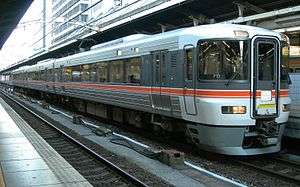373 series
| 373 series | |
|---|---|
|
373 series on a Home Liner service, April 2010 | |
| In service | October 1995–Present |
| Manufacturer | Hitachi, Nippon Sharyo |
| Replaced | 165 series |
| Constructed | 1995–1996 |
| Number built | 42 vehicles (14 sets) |
| Number in service | 42 vehicles (14 sets) |
| Formation | 3 cars per trainset |
| Operator(s) | JR Central |
| Depot(s) | Shizuoka |
| Specifications | |
| Car body construction | Stainless steel |
| Car length | 21,300 mm (69 ft 11 in) |
| Width | 2,947 mm (9 ft 8.0 in) |
| Height | 4,020 mm (13 ft 2 in) |
| Doors | Sliding doors (2 pairs per side) |
| Maximum speed | 120 km/h (75 mph) |
| Traction system | GTO-VVVF |
| Electric system(s) | 1,500 V DC overhead line |
| Track gauge | 1,067 mm (3 ft 6 in) |
The 373 series (373系) is an electric multiple unit (EMU) train type operated by Central Japan Railway Company (JR Central) on mid-distance limited express services in Japan since October 1995.[1]
Design
The trains were built jointly by Hitachi and Nippon Sharyo.[2]
Operations
As of 2011, the 373 series sets are used on the following services.[3]
- Wide View Fujikawa (Shizuoka – Kōfu) (since 1 October 1995)[4]
- Inaji (Toyohashi – Iida) (since 16 March 1996)[4]
- Home Liner Numazu
- Home Liner Hamamatsu
- Home Liner Shizuoka
373 series sets were formerly used on Wide View Tokai limited express services between Tokyo and Shizuoka from 16 March 1996 until 17 March 2007,[4] and on Moonlight Nagara overnight rapid services between Tokyo and Ōgaki from 16 March 1996 until 14 March 2009.[3]
Formation
The 3-car sets, numbered F1 to F14, are formed as follows.[1][3]
| Car No. | 1 | 2 | 3 |
|---|---|---|---|
| Designation | Tc' | T | Mc |
| Numbering | KuHa 372 | SaHa 373 | KuMoHa 373 |
| Capacity | 52 | 68 | 60 |
The KuMoHa 373 car is fitted with one C-PS27G single-arm pantograph.[3]
-

KuHa 372-11
-

SaHa 373-11
-

KuMoHa 373-11
Interior
The 3-car sets are monoclass with rotating/reclining 2+2 seating arranged with a seat pitch of 970 mm. The KuMoHa 373 and SaHa 373 cars have fixed 4-seat "semi-compartment" bays at the ends of the cars with large tables.[5]
History
The first sets were delivered from Nippon Sharyo in August 1995,[3] entering revenue service from 1 October 1995 on Wide View Fujikawa services.[4]
From 18 March 2007, all cars were made no-smoking.[3]
References
- 1 2 JR全車輌ハンドブック2009 [JR Rolling Stock Handbook 2009]. Japan: Neko Publishing. 2009. p. 165. ISBN 978-4-7770-0836-0.
- ↑ Saka, Masahiro (March 2014). "JR第1世代の車両・現況と概要" [JR 1st-generation rolling stock: Current situation and overview]. Tetsudō Daiya Jōhō Magazine (in Japanese). Japan: Kōtsū Shimbun. 43 (359): 22.
- 1 2 3 4 5 6 JR電車編成表 2011夏 [JR EMU Formations - Summer 2011]. Japan: JRR. May 2010. p. 116. ISBN 978-4-330-21211-1.
- 1 2 3 4 JR新幹線&特急列車ファイル [JR Shinkansen & Limited Express Train File]. Japan: Kōtsū Shimbun. 2008. pp. 30–32. ISBN 978-4-330-00608-6.
- ↑ こだわりの新幹線&特急列車ガイド [In-depth Shinkansen & Limited Express Guide]. Japan: Ikaros Publishing. August 2000. pp. 94–96. ISBN 4-87149-284-2.
External links
| Wikimedia Commons has media related to 373 series. |
- JR Central 373 series information (Japanese)

